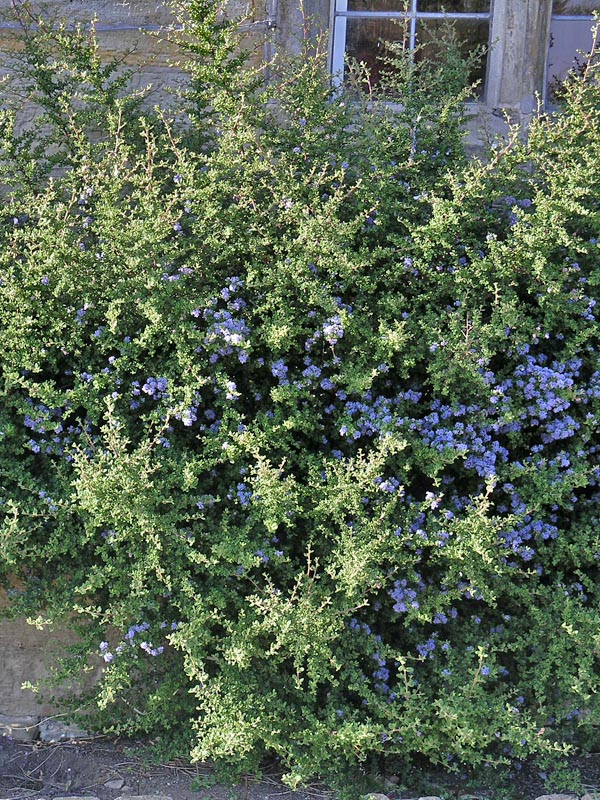
Woody > Ceanothus > Ceanothus impressus > Ceanothus impressus
Ceanothus impressus
Santa Barbara Ceanothus
Origin: Coastal California, United States of America.
Mike's
Opinion


"
Often confused for a lilac because of its blooms, Ceanothus impressus is a desirable plant with its lovely clusters of medium blue flowers. It is slightly fragrant and extremely hardy. Most effective as a specimen due to its irregular, arching form, Ceanothus impressus is an admirable shrub that brings striking colour to any landscape.
Michael Pascoe, NDP., ODH., CLT., MSc. (Plant Conservation)
"
| Family |
| Rhamnaceae |
| Genus |
| Ceanothus |
| Species |
| impressus |
| Category |
| Woody |
| Type |
| Shrub (evergreen) |
| Pronunciation |
| USDA Hardiness Zone |
| 9 |
| Canadian Hardiness Zone |
| Requires cool season protection under glass. |
| RHS Hardiness Zone |
| H4 |
| Temperature (°C) |
| -7 -(-1) |
| Temperature (°F) |
| 25 - 35 |
| Height |
| 3 m |
| Spread |
| 7 m |
Photographs
Description and Growing Information
Flowering Period
| General Description |
| A large shrub with beautiful blue/violet flowers with a slightly sweet aroma. Its pollen is attracts bees. |
| Landscape |
| Can be used as a main specimen or as filler/buffer. Planted for its striking colour and slightly sweet aroma, can stand alone or be mixed with other shrubs in a garden bed. |
| Cultivation |
| Plant in well drained, moist soils in full sun to partial shade. Drought tolerant. Tolerant of low pH. Light pruning is required to maintain a manageable shape. Do not prune wood that is thicker than a pencil. |
| Shape |
| Irregular, slightly rounded with extending branches. |
| Growth |
| Fast |
| ID Characteristic |
| Clusters of lovely medium blue flowers producing a mild, sweet fragrance. Form is slightly chaotic if left unpruned. |
| Pests |
| No serious pests however, Ceanothus stem gall moth and aphids are not uncommon. |
| Habitat |
| Central coast of California and on slopes and mesas, at elevations of 0-200 m. |
| Bark/Stem Description |
| The twigs and stems are dark brown and smooth to the touch, while the roots have red inner wood. |
| Leaf Description |
| Approximately 2 cm long and ovate, leaves have many ridges and wrinkle slightly, most have grey, soft haired undersides. |
| Flower Description |
| Flower buds are between 1-2 cm across, growing in clusters with fine hairs covering the surface. Deepening in colour as they mature, the buds change from red to purple to blue. Flowers are tiny and grow in inflorescences, varying from blue to pale violet. From a distance the plant appears as one solid mass of blue foliage. |
| Fruit Description |
| 4 mm in width; fruit is a dark purple, rounded capsule. |
| Colour Description |
| Deeply green leaves; medium blue to pale violet blooms; light green stems (new growth) with greyish brown older wood. |
| Texture Description |
| Soft, fine textured blooms with ridged, wrinkled leaves. New wood is waxy to the touch, while older wood is smooth. Flowers are delicately soft. |
| Propagation |
| Propagating from seed requires soaking in tepid water before chilling at 1° for several months, followed by scarification. Can also be propagated from softwood cuttings from mid summer to early autumn. |
| Ethnobotanical Uses (Disclaimer) |
| Green dye can be extracted from the foliage and leaves are high in saponins, which when combined with water produce a mild, gentle soap. |
References
Brickell, Christopher. “The American Horticultural Society: Pruning & Training.” New York: DK Publishing Book, 1996.

